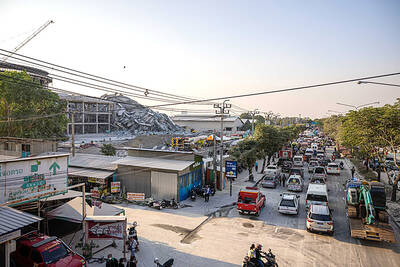National Sun Yat-sen University professor Chen Yang-yi’s (陳陽益) dream of using the Kuroshio Current to generate electricity has been proved viable after seven years of testing, and Chen hopes that by 2020 the project would be able to produce 1 gigawatt (GW) of electricity per day.
Chen’s research team said that it reported the results to Premier Lin Chuan (林全) on Saturday.
According to Chen, the Kuroshio Power Plant Development Project late last month successfully deployed a floating platform anchored to a sunken ship, the first such platform in Taiwan and the first system to test the viability of power generation by ocean currents.
The project was the first to turn on low-speed generators submerged in water currents flowing at 0.45m per second, Chen said, adding that the generators were kept running for 60 hours.
The team first used tugboats off Pingtung County’s Siaoliouciou Island (小琉球) last year to tow their third generator through ocean currents at a speed of 1.43m per second, Chen said, adding that average power generation was 32.57 kilowatts (kW).
That was the first time a research team towed a generator to simulate ocean current speeds and generated power, Chen said.
On July 23, the team deployed a multipurpose platform 25km southeast of Oluanpi (鵝鑾鼻), which it anchored to a foundation 900m deep converted from an abandoned ship, Chen said.
From July 25 to July 29, the team ran consecutive tests as the Kuroshio Current flowed past the platform at a depth of 30m, with currents traveling at 1.27m per second, generating an average of 26.31kW, he said.
“It was a successful trial,” Chen said.
The team plans to move to Jioupeng Bay (九鵬灣) in Pingtung next year for a trial run, which it hopes will generate 2 megawatts for commercial operations, Chen said
If the test results are positive, the system could become a replacement for the Ma-anshan Nuclear Power Plant, as it is projected to be able to generate 1GW by 2020, which would move the nation one step closer to the government’s goal of a “nuclear-power-free homeland.”
While many nations have been attempting to use sea currents to generate power, most are still at the design stage and none have had a successful trial, he said.
According to Chen, Japan last year demonstrated a sea current generation system, but said that it would not conduct live trials until 2020, meaning that Taiwan’s research has surpassed that of other nations.
Chen, who served as president of the university’s College of Marine Science, launched the Kuroshio Current power generation research project in 2009 in collaboration with research teams from the National Applied Research Laboratories and National Cheng Kung University’s Tainan Hydraulics Laboratory.
The team also collaborates with Wanchi Steel Industrial Co (萬機鋼鐵) on technological matters.

AIR SUPPORT: The Ministry of National Defense thanked the US for the delivery, adding that it was an indicator of the White House’s commitment to the Taiwan Relations Act Deputy Minister of National Defense Po Horng-huei (柏鴻輝) and Representative to the US Alexander Yui on Friday attended a delivery ceremony for the first of Taiwan’s long-awaited 66 F-16C/D Block 70 jets at a Lockheed Martin Corp factory in Greenville, South Carolina. “We are so proud to be the global home of the F-16 and to support Taiwan’s air defense capabilities,” US Representative William Timmons wrote on X, alongside a photograph of Taiwanese and US officials at the event. The F-16C/D Block 70 jets Taiwan ordered have the same capabilities as aircraft that had been upgraded to F-16Vs. The batch of Lockheed Martin

GRIDLOCK: The National Fire Agency’s Special Search and Rescue team is on standby to travel to the countries to help out with the rescue effort A powerful earthquake rocked Myanmar and neighboring Thailand yesterday, killing at least three people in Bangkok and burying dozens when a high-rise building under construction collapsed. Footage shared on social media from Myanmar’s second-largest city showed widespread destruction, raising fears that many were trapped under the rubble or killed. The magnitude 7.7 earthquake, with an epicenter near Mandalay in Myanmar, struck at midday and was followed by a strong magnitude 6.4 aftershock. The extent of death, injury and destruction — especially in Myanmar, which is embroiled in a civil war and where information is tightly controlled at the best of times —

Taiwan was ranked the fourth-safest country in the world with a score of 82.9, trailing only Andorra, the United Arab Emirates and Qatar in Numbeo’s Safety Index by Country report. Taiwan’s score improved by 0.1 points compared with last year’s mid-year report, which had Taiwan fourth with a score of 82.8. However, both scores were lower than in last year’s first review, when Taiwan scored 83.3, and are a long way from when Taiwan was named the second-safest country in the world in 2021, scoring 84.8. Taiwan ranked higher than Singapore in ninth with a score of 77.4 and Japan in 10th with

China's military today said it began joint army, navy and rocket force exercises around Taiwan to "serve as a stern warning and powerful deterrent against Taiwanese independence," calling President William Lai (賴清德) a "parasite." The exercises come after Lai called Beijing a "foreign hostile force" last month. More than 10 Chinese military ships approached close to Taiwan's 24 nautical mile (44.4km) contiguous zone this morning and Taiwan sent its own warships to respond, two senior Taiwanese officials said. Taiwan has not yet detected any live fire by the Chinese military so far, one of the officials said. The drills took place after US Secretary